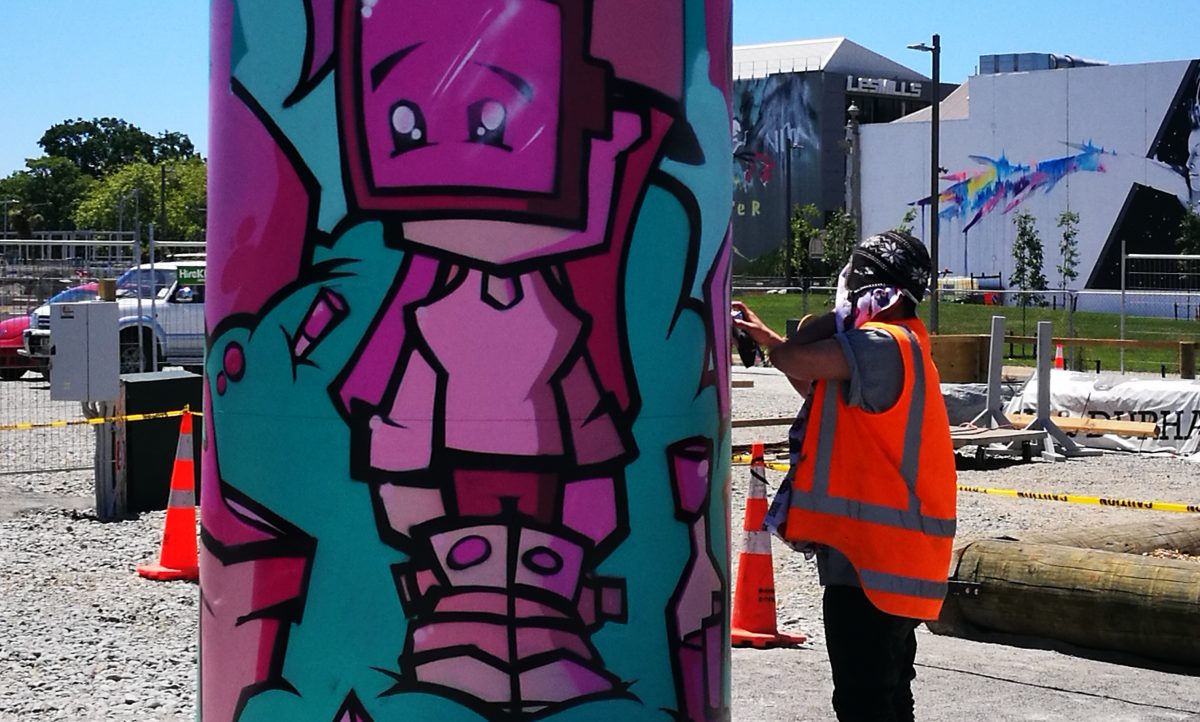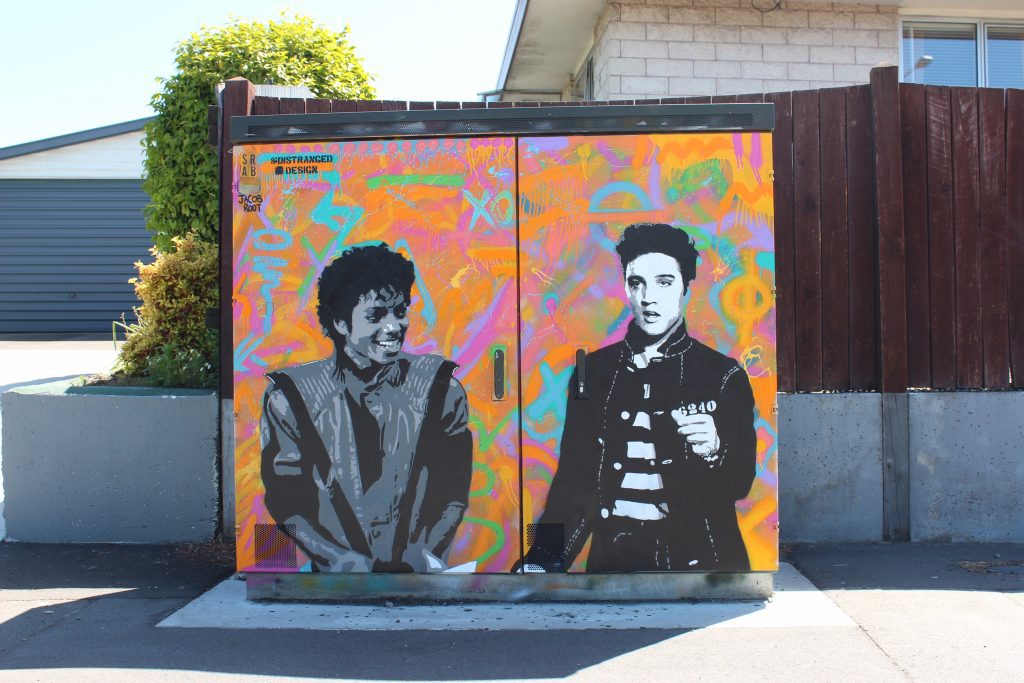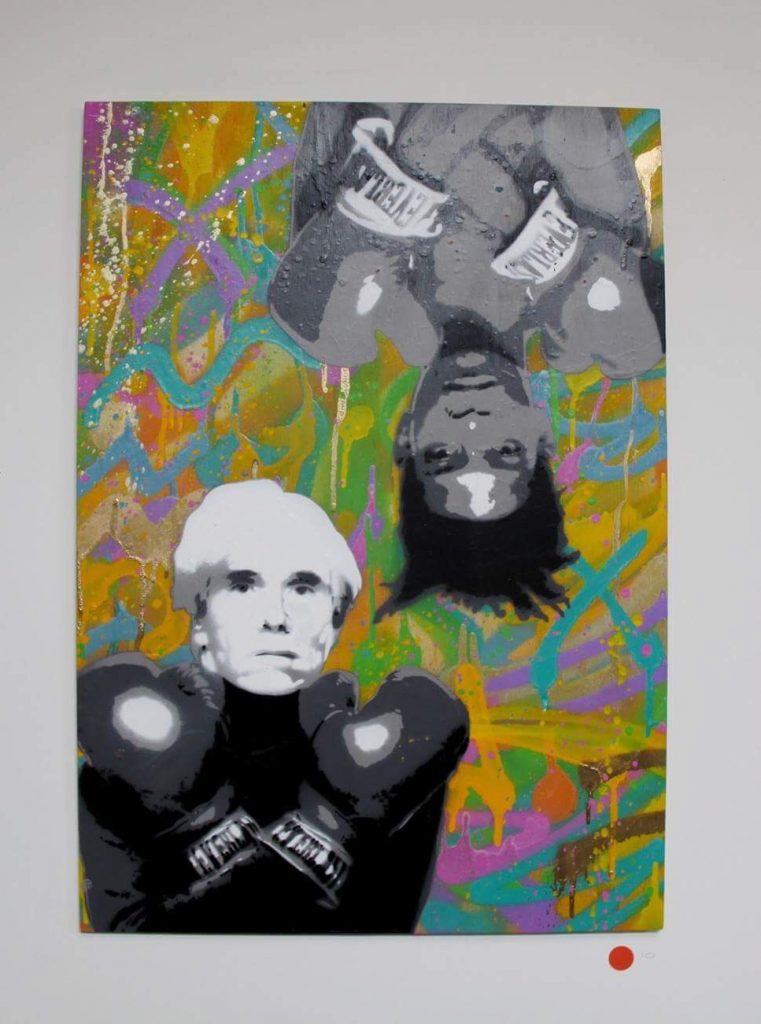He won’t remember, but I first met Ikarus in the early 2000s. I was a University student and as part of a course on hip hop culture I was taking, Ikarus was painting a demonstration piece as part of a ‘hip hop summit’, as the lecturer called it, at the old student’s association bar. I had taken every opportunity in my studies to write about my fascination of graffiti and street art, and I spent the afternoon intently watching Ikarus paint. I meekly mentioned my interest in graffiti, but understandably, Ikarus seemed non-fussed by some student type’s attraction to a culture that he lived and breathed in real life, not in essays, only serving me a nodding acknowledgement. Close to ten years later, I was re-introduced to Ikarus for a project in the central city Re:Start Mall , affording me the chance to work with him and Wongi ‘Freak’ Wilson. Since that re-introduction, I have been able to get to know Ikarus as the funny, acerbic and insightful personality he is. Fortunately, now I consider him a go-to figure for advice and opinions on graffiti matters. I even joked with him that when I have to reflect on any writing or statements, I use the phase ‘What Would Ikarus Think?’
While he laughed my motto off, Ikarus is deserving of his place as a true legend of Christchurch graffiti art. From his early days getting up in the streets, his place in the mighty DTR crew, working as a mentor and tutor for Project Legit, and his involvement in the Rise and Spectrum shows alongside countless independent productions, he has earned respect. Over the years he has forged strong opinions on graffiti’s traditions and history, as well as the rise of the mural art movement that he finds himself part of, despite never holding such goals as a young graffiti writer, reflections that show a deep understanding of his, and the culture’s roots and potential futures.
In early December, we sat in a loud, windy laneway in the Central City and over pizza slices, discussed some of Ikarus’ recent projects, his take on graffiti and street art, and his own work’s development over a long and winding path…
So, Ikarus, you have a couple of busy weekends ahead, this weekend is the opening of the East Frame youth space, where you, Freak and Yikes are painting three of the Oi YOU! donated spray cans (with other selected artists painting the five other cans), and then next weekend you’re off to Auckland for Berst’s Forum event, which will have you painting, giving an artist talk, and are you part of the event workshop?
No, we go home before the workshop, but we’re painting a couple of walls. They got us one wall that we have to paint and then there’s a couple of optional ones during the weekend as well, which we can do…
As for this weekend, give us a little bit of background as to how you guys came to be involved in the youth space project and the idea behind the giant spray cans…
Basically, we were approached by Oi YOU! and GapFiller regarding the installation. Oi YOU! donated the eight large spray cans, and GapFiller along with Fletcher Living, have created this youth space. The whole youth space itself is going to have a basketball court, a café, a little youth centre area, and of course the spray cans. The way that it’s going to work is that three of the cans will be sectioned off and will be for semi-permanent to permanent works, and myself Yikes and Freak will be painting those tomorrow, and the other five grouped together will be what they’re calling an evolving art space, which will be an open space where young artists can practice and not worry about getting into trouble. It’s kind of the first spot actually in the city that’s been officially declared for young people to come and practice their stuff, so that’s really good…
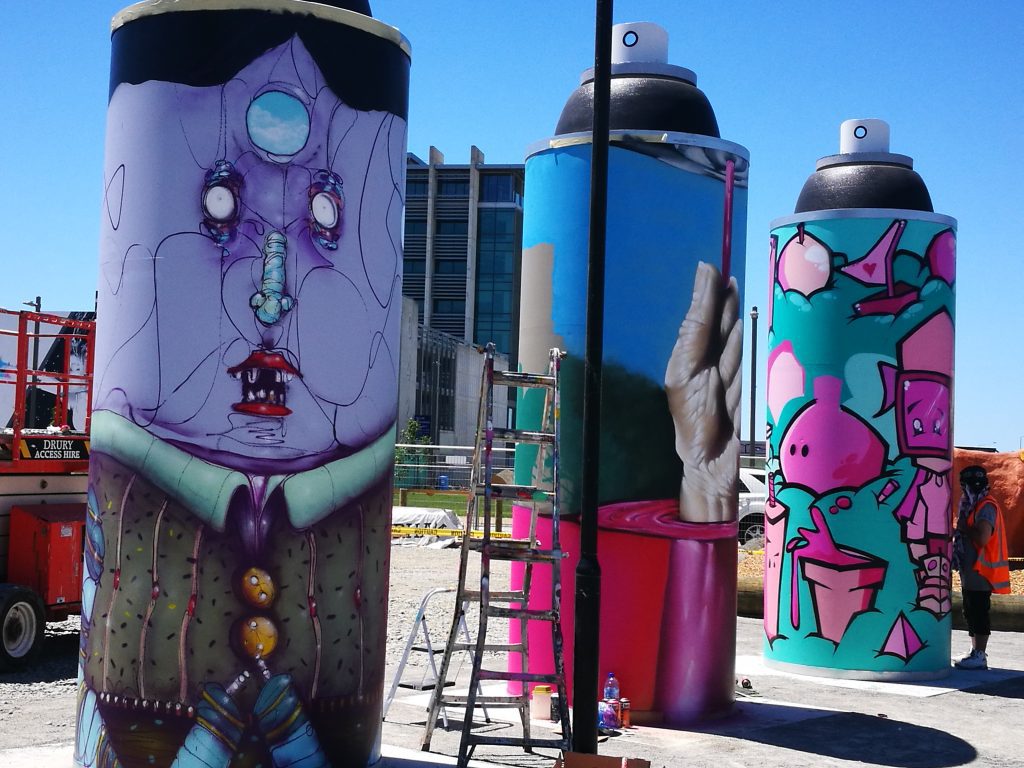
You’ve been pushing for this kind of concept, as an alternative to kids ending up in other spaces, for quite a while and yet you’ve always met some resistance, so what do you think has made this possible now?
Part of it would have a lot to do with the amount of different graffiti art and street art that’s been popping up over the last few years. Public perception towards it has changed a lot than, you know, ten years ago. People see it as a much more positive thing after the earthquakes when the city was really destroyed. A lot of people started to appreciate the splashes of colour and pictures and stuff everywhere. But also, Oi YOU! donating the spots and then GapFiller having done so many different projects over the years, I guess those two names and the results that they’ve shown over the years for projects that they’ve done, I think that probably helped sway the Council towards them giving it a shot. And yeah, like you say, I’ve been trying argue the point for legal walls for a few years now because obviously kids are going to go and practice somewhere and you may as well structure a place where they can do that without fear of getting into trouble, because you know it wastes a lot of tax payer money just to have the Police called and they’ve gotta go down there and chase it up and whether they end up arresting them and charging them, I mean it’s all those things, it’s counter productive and also leads that kid to have a bad attitude about the community, about the Police and you know about the Council and stuff. Even symbolically, having eight giant spray cans in the middle of the city is a crazy thing in far as it being a statement on Christchurch’s part that they now view graffiti and street art as forms of art. So now it’s really good to have a spot where kids can actually come and practice and try and hone their talents and turn it into something more positive than it has been in the past.
Spray cans have had this sort of stigma attached to them for a long time, so as you say, symbolically, these objects show a shifting of the guard. I also remember you saying quite often that what authorities are doing, what they have been doing, is not working, that it’s time to change and try something new…
Yeah, exactly, I mean it’s that classic saying: the definition of insanity is to continue doing something that isn’t working, and expecting a different result. For years the policy or the stance has been anti-graffiti, anti-tagging. It’s been catch a kid tagging and whether they arrest them, charge them with wilful damage, give them community service, or on a couple of occasions people have done small prison sentences for it, but like I say, all that does is foster negative energy and it’s a lot easier for a young person, if they are interested in the art form, it’s way easier for them to get one can of spray paint and go out and write their name on a bunch of stuff than it is for them to be able to gather half a dozen to a dozen cans of spray paint and then find somewhere that their allowed to go and practice. It’s sort of like the proactive vs reactive measure you know, there’s not much point just continually catching kids that are doing it, punishing them and then having no real change. I haven’t seen the statistics, but I’d be surprised if graffiti ever went down based on that approach…
It’s important to reflect on whether the culture of today would exist if there wasn’t that history of having to react against the institutional response. I mean there’s now this really big divergence in how artists come to be defined as ‘street artists’, but a lot of the roots of what is now this immensely popular culture, have to be acknowledged as coming from the resistant nature of graffiti right? It’s born from the need for people to express themselves and to get out and do it. You’re a traditionalist around this in some regards, and it’s going to exist either way, but as you say, just giving a space like this which is going to remove some negative energy is a positive move…
Yeah, one of the things I would always try to explain if I was having this conversation with Council members or just general members of the public that don’t understand the whole art form, is that graffiti and vandalism is going to exist because its so easy. It’s always existed you know, people have written their name on things before spray cans and before graffiti as the culture we know it today was born, people were still writing their names on things. When we were young and there was nowhere for us to paint, the only reason that we got to learn the things we did was because people we knew gave us places to paint. There were a couple of walls you were allowed to paint, like we’d gotten through, not public ones but through owners of buildings and places. So we would have our own spaces to paint, and without that we would’ve, I would’ve just kept on the same path without ever probably evolving into anything else.
Graffiti also suggests that you can understand urban space in a different way through commandeering areas. Graffiti writing is kind of symptomatic of the ability to navigate a space whether you are given permission or not. A graffiti writer will go to those places that a normal member of the public shies away from. I think there is something interesting in that, and particularly in Christchurch, where we’ve had so many spaces that have been empty or available, but now these spaces are being redefined. There will always be a need for people who head out and explore the city and actually illustrate to other people that there are spaces we ignore or forget or don’t know…
Yeah, absolutely, a lot of that has to do with the fact that originally and historically graffiti has that stigma attached to it, and oftentimes it is forced into those areas because they are the spaces that the general public aren’t paying attention to, you know like an abandoned building, your train lines, your rooftops in the middle of the night, your alleyways, stuff like that where regular people aren’t going to be as much, so it was sort of a necessary thing. Plus there’s that aspect that graffiti and street art are, or in the past have been, largely youth cultures, and as a teenager you’re always out exploring a city, through skateboarding or graffiti, or whether it’s just through being among friends. Like when I was young, long before we were even thinking about graffiti, we used to climb a lot of rooftops around the city just because it was accessible, and we wanted to see what’s there and you want to be there. Graffiti became that thing where like I will make a small mark so that the next person that comes will know that I was here as well. It has all grown from that.
Post-quake there is a new generation that have experienced this really unique landscape where there has been so much access to the myriad damaged and abandoned places, so it will be interesting to see where these creative impulses lead a newer generation who have grown up knowing a city that is basically a giant playground…
One giant playground for that sort of thing, absolutely. We’ve definitely had that conversation among ourselves that if we were younger and still in our earlier destructive phases (laughs), when this all happened it would’ve just been like the biggest playground! It has, not necessarily created, but spawned a lot of extra graffiti and vandalism and art because things were in such a state of disrepair, because youth are going to go out and explore these areas, they really blew up. But then also because it had such a huge visual impact, because there was so much, you started to get more and more regular people taking notice of it, and now you know there’s a lot of areas, and I’m not talking about large scale murals, I’m talking about like some of the car parks and alleyways around the city that have just traditional graffiti characters and name pieces where like no matter what time of the day you’re there, you’re generally going to run into people who are there taking photos, whether it’s people who live here, or tourists that have come to see the city in the way it is. I feel like we’ve got a lot of earthquake and graffiti and street art tourism in the last few years, so there’s just constantly people in all these areas now. But ten years ago, even if we were painting a legal commissioned wall, people would see us and call the Police. People would think we were doing something wrong until we spoke to them. Now, 95 to 98 per cent of the feedback you get from your average pedestrian or onlooker as they come past is all super positive and especially from Christchurch residents, you know a lot of them have told us stories about how seeing a certain work really uplifted their spirits in times when everything was super bleak around here…
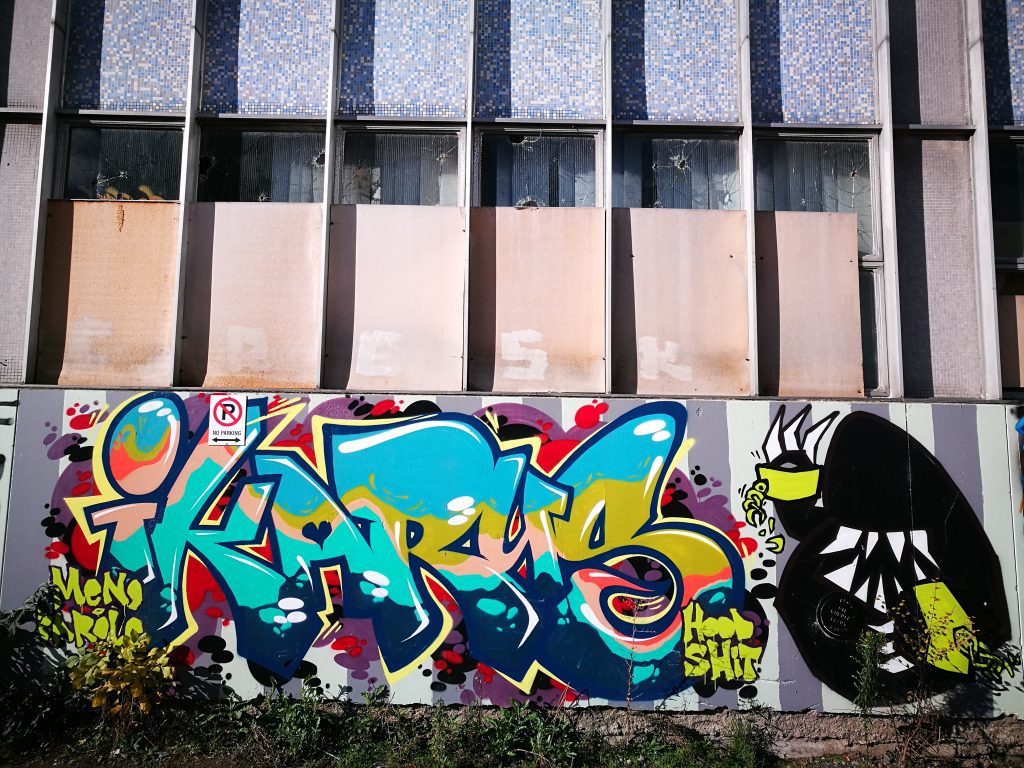
That broken environment exacerbated the impact that those sorts of expressions can have. The interesting thing now is how people reconcile the shiny glass facades that have popped up everywhere against the knowledge that there are all these other types of expression that can make a city lively and vibrant as well. It will be interesting to see how those reactions evolve…
Yeah, definitely, I feel like during the rebuild there has been a really great amount of integration of art and large-scale mural work alongside the rebuilding of the city. It’s becoming a focal point. People see these big walls they have and see there’s an opportunity for a good piece of art or a large-scale work. I think that’s possibly going to continue until it bottlenecks, and everything has something large scale on it… (laughs)
I think the interesting thing is how the different types co-exist, because, as you say, the large-scale murals are generally going to bottleneck, there are only so many walls. But there will always be other smaller spaces for people to leave a mark as well…
There’s only so many artists as well…
Especially wen it comes to artists who have the experience to work on a larger scale, the chance to get to that level is, at least traditionally, tied to those smaller spaces…
Yeah.
So, the Forum event in Auckland is a good chance to connect with other well-known graffiti artists, which must be pretty exciting. Berst has organised the event and he is a pretty key figure in the New Zealand graffiti scene, what is your relationship with him like?
Yeah for sure man, it’s exciting but also just fills me with dread and anxiety! There will be a couple of top tier guys there, but we know these dudes, we’ve met them and painted with them several times over the years. We met Berst in like 2006-07, and back then he was just a super active graffiti writer. He was really amazing, literally the first time we went painting with him I was amazed, but he was just a regular cat man, painting a bunch of freights. But he was super motivated though, that’s the difference. He’s a bit of a super human you know, and he’s really active in trying to widen, I mean similar to what Freak and myself have been doing for years, just trying to widen the general public’s perspective on what graffiti is, what street art is… The event is called ‘Forum’ and maybe half a dozen to ten artists are coming from various places around the country, a couple from Wellington, some Aucklanders. Everybody who is doing it is coming from a different avenue, some are graphic designers for example. Myself, I’ll be speaking about my time with Project Legit, back in 2008-10, as well as some of the stuff we’re doing now, like the youth space project, the workshop stuff we do. Freak [Wongi ‘Freak’ Wilson] is going to talk about his business. It’s sort of a talk about the various offshoots that graffiti has led a lot of people to. There is a lot of stuff that I never would’ve imagined doing or even that I was aiming towards when I first started out, so it’s good to give people an idea about this, about what is behind it, and what can come of it as well…
How you see the traditions of graffiti fitting into what is now commonly referred to as the ‘street art’ movement (which is a problematic term anyway). Specifically in a formal sense, because the formal elements of graffiti, the letterforms, even the elements like character work, the techniques that are important for graffiti writers, they’re distinct and street art has sort of opened this big bag of other approaches which are not perhaps faced with the same stigmas that graffiti writing has had to deal with. As someone who is a graffiti writer and a constant defender of it…
Staunch defender, advocate!
How do you place it within everything that is going on and how have you managed to maintain your roots as you’ve been part of it as well?
The bottom line of all of it is, I feel like with this new wave of street art, and this isn’t to bag any particular image or artist or anything, in regards to the large-scale murals, but a portrait of a face, paint a giant bird, you know, paint a nature scene, give them a pukeko and some native fauna or flora, and it’s an easy sell, you know what I mean? It’s easily digestible and palatable to the public. It’s a commodity and it’s able to be commercialised in that respect. While all of those things are great, a lot depends on where an artist has come from and their general stance on various aspects of it. Like you say, traditional graffiti in the way of name-based colourful pieces, cartoon style characters, bright cartoony colour combos, stuff like that, is often, I feel, driven to the wayside in the wake of this new emerging style of street art and street murals and large-scale work. They are all great together, but I personally would hate to see the traditional stuff pushed all the way out of the way for the new stuff. As anybody who has sort of invested in the history of any movement, the new stuff couldn’t exist without the old stuff, and I feel like it has to have some sort of precedence, it has to have some sort of importance.
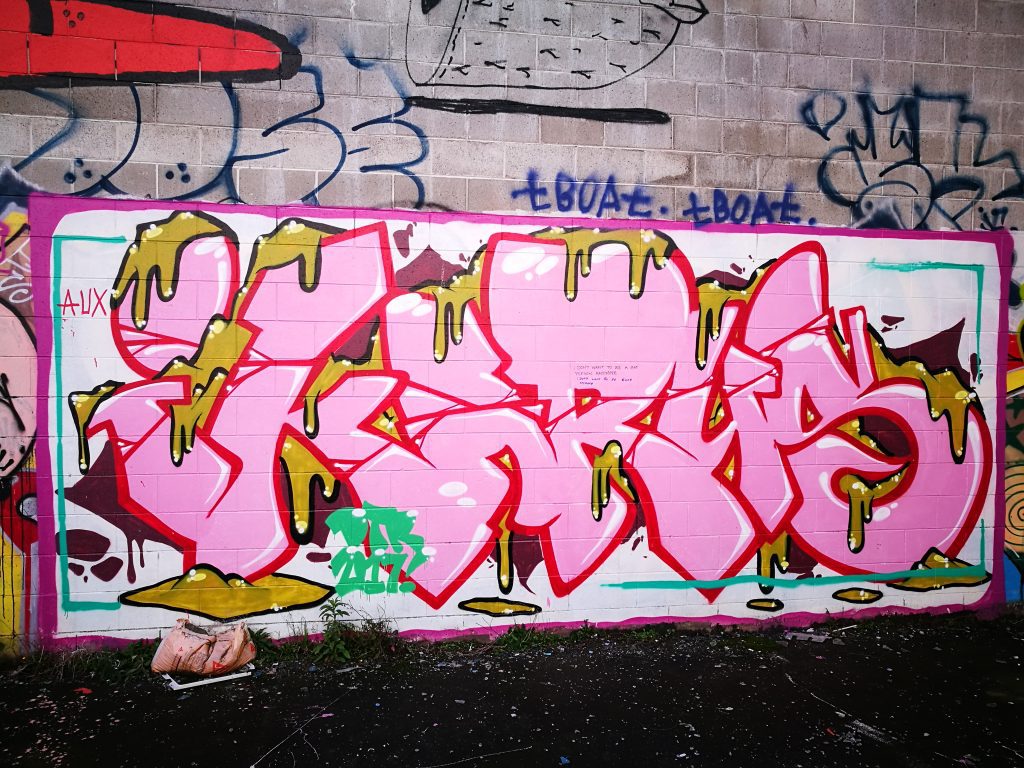
Talking about lineage and legacy, I’m thinking about some street art imagery and some of the imagery you’ve talked about, and you know often it’s coming from people commissioning work rather than artists. Because if you think about some of the imagery that would have defined street art at the turn of Millennium, it was those subversive riffs on popular culture, and you don’t really see those images turned into murals either. Likewise, it can still be hard for artists to get the chance to do something abstract when it comes to commissioned work (at least in Christchurch), and with letterforms there’s a lot of the same qualities as abstraction as well, so many artists have to exist within this compromised, dichotomous approach: “this is what I want to do, but this is what I’m going to have to do…”, and reconciling that becomes a real challenge…
Yeah absolutely, I find it the same. I do a certain amount of commercial work and from time to time the subject matter is going be something you’re not the most stoked about, but as long as you can keep it true to your own style and the definition of what you’re doing, then you can basically do it. Like I say, the bottom line with graffiti, and the whole idea of it as an art form, is that you do what you want to do, but with that said, within a defined set of rules and guidelines, an as much as you can bend and break those guidelines you do need to know them, to know the history. I mean it’s the same as any culture, you’ve got to learn to walk before you can run and you’ve got to know something of the history of the thing you’re interested in and where it came from…
Like you said earlier, some of the defining characteristics of graffiti, it doesn’t seem like people should have such an antipathy to things like bright colours, names, cartoony characters… We all write our names thousands and thousands of times over and over again, we use signatures in our day to day business, and we take pride in our signatures, so there’s not that much difference, but that affront to private property overrides any aesthetic enjoyment…
Yeah and that’s it, traditional graffiti in its name-based, character-based cartoony form, is of course derived from tagging and vandalism and destruction of property, so it is always going be tied in with that. Newer street art, like with a bird, or scenery, or a portrait, is very far removed visually from the idea of writing a name. Often as well, the mediums the new artists are using, it’s paint rollers, brush work, there are still cans involved, but it’s not the same thing, and I think that lends to the palatability of the new forms of street art and mural work. Whereas traditional graffiti as an art form is always going be difficult, and so it should be. But they are branches of the same tree, it’s an evolution. Graffiti as an art form is an evolution of a basic signature, it’s all based around a name and around having your name known, manipulating letters, the structure of letterforms, working with different colour palettes to create something unique and visually appealing. But yeah, like I say, the main problem it has as an art form and the main reason it is held back is that vandalism side. Plus, a lot of people that are practitioners, traditional graffiti-style artists are perhaps not the most personable people (laughs). You know they are not always the most eloquent, they don’t always want to explain themselves. We’ve gotten good at it because we’ve spent years at the forefront of it, trying to change people’s perception of it, so there’s sort of like a bunch of go to phrases and references, that I can draw on.
Check in next week for Part 2, where we talk about the public perception of graffiti and the technical qualities people don’t necessarily see, Ikarus’ own stylistic development and influences as well as some of his experiences in Christchurch’s post-quake explosion of art in the streets…

